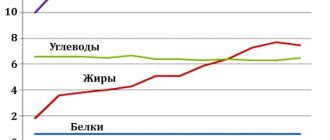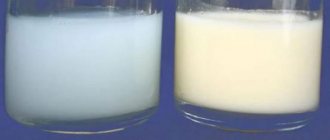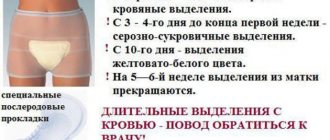Why are breasts tightened?
A seemingly folk remedy for stopping lactation, breast tightening, turns out to be widely used by medical professionals:
- The need to stop breastfeeding for medical reasons. In this case, there is a risk of infecting the child with infectious diseases through milk: AIDS or infectious mastitis. The presence of inflammatory processes, intestinal infections or viral diseases are not indicators of cessation of lactation.
- The mother's desire to stop breastfeeding. Doctors do not recommend depriving a baby under 1 year of age of mother’s milk, since it is the key to a healthy immune system in the future, as well as successful and prosperous physical and mental development. The method of ligating the breast to end the lactation period is, of course, very effective, but it is not the most humane in relation to the breast itself. This method should be used when it is necessary to “curtail” breastfeeding as soon as possible.
READ ALSO: How to properly wean a child from breastfeeding at 1 year?
Ligating the glands does not mean reducing milk production or reducing their volume. You can often hear the opinion of lactation specialists that this is absolutely useless from a physiological point of view.
It is impossible not to notice, however, the effectiveness of this method. The milk ducts are blocked, and the glands are filled with milk less intensely, and, consequently, lactation gradually fades away. Full breasts, tightly fixed under the bandage, do not cause such severe discomfort as it would have been without it.
Is it necessary to transfer breast milk?
In most cases, breast constriction is used to quickly stop breastfeeding. This method belongs to folk methods. Its use is practiced in the following cases:
- When it is necessary to stop lactation for medical reasons. This situation occurs when continued feeding may harm the baby. Lactation is stopped if the mother has infectious diseases. These include AIDS and infectious mastitis.
- When lactation stops on the initiative of the mother. It is not recommended to stop breastfeeding until the child reaches 1 year of age. Breast milk contributes to the formation of a healthy immune system, harmonious physical and psychological development. After 1 year, a mother can stop breastfeeding, and this will not have a negative impact on the baby’s development. It is for this purpose that the breast ligation method is practiced.
Correct technique
There is only one method of breast tightening: tight fixation of the chest area over the entire surface. It looks like this:
- A cotton sheet, wide towel or diaper is suitable for wrapping.
- Tighten the chest from the armpits to the lower ribs.
- Tie the ends of the sheets and towels in the area of the shoulder blades. It is advisable to involve your spouse in the procedure. The pressure should be strong, but not traumatic or painful.
For fear of making a mistake, you can watch video and photo lessons on how to properly apply such a fixing bandage. The wrap should be done only after the baby has completely emptied the breast. The breasts should be soft to the touch. There is no need to walk around tied all day. How long should such a bandage be worn then? A few hours a day will be enough.
All about proper technique
There is no certain number of universal techniques that make it possible to properly transfer breast milk. The only way involves tightly fixing the mammary glands over their entire surface. The procedure in this case is carried out according to a certain algorithm.
First of all, you need to take a sheet or wide towel to bandage the chest.
It is permissible to use thin cotton fabric, which should fit snugly to the body. After this, the presented layer is applied to the mammary glands. They need to be covered completely, namely from the armpits to the bottom of the ribs.
Should your breasts hurt during a frozen pregnancy?
It is quite difficult to do this on your own, and therefore it is recommended to ask your husband or anyone else who is nearby for help. It is important that the ends of the towel are tied with tight knots or one knot between the shoulder blades, which must be used to tie the glands. Mammologists pay attention to the fact that fixation should remain strong and, at the same time, not traumatic. When tightening, as in the photo, a woman should not experience pain.
It is recommended to apply a bandage after the baby has emptied the breast on his own, that is, exclusively after lactation. It is necessary that it be soft, that is, ideal for dressing. There is no need to keep it in this state for 24 hours; using the bandage for several hours a day will be sufficient.
Misconceptions about tight dressings
When ligating the breasts, some women are mistaken about the following points:
- If you start to over-tighten, deprive your baby of milk. This scenario is possible for medical reasons. Making an independent decision to stop lactation should be accompanied by more gentle conditions for the child. The baby should be weaned off the breast gradually, over 7-10 days. Reducing the number of daily feedings will reduce milk production, and dressing will create the conditions for smaller hot flashes.
- There is no need to express when changing the dressing. The milk does not “burn out” because of the bandage and it is very dangerous to think so (we recommend reading: how long does it take for breast milk to burn out after completely stopping feeding?)! Excessive accumulation of milk in the glands leads to the formation of lactostasis, and to prevent stagnation, milk must be expressed. Within a week, the untreated areas develop into mastitis. Be sure to express your breasts if you experience pain from swelling (for more details, see the article: How to manually express breast milk?). You can’t express everything, but only to the point of ease. It is better to use a breast pump for pumping; it provides better breast release. Mammologists recommend expressing by hand - a more delicate procedure is an excellent prevention of mastitis.
READ ALSO: pills to stop lactation
When you stop feeding your baby your milk, you need to know how to properly transfer the milk (we recommend reading: how to stop feeding breast milk correctly?). This is important for every mother to know. Using this procedure, you can not only complete breastfeeding, but also regulate the volume of incoming milk. If the flow of milk is too active, you can bandage the breasts after each feeding for 2 hours (see also: is it necessary to express milk after each feeding?).
How to retighten correctly
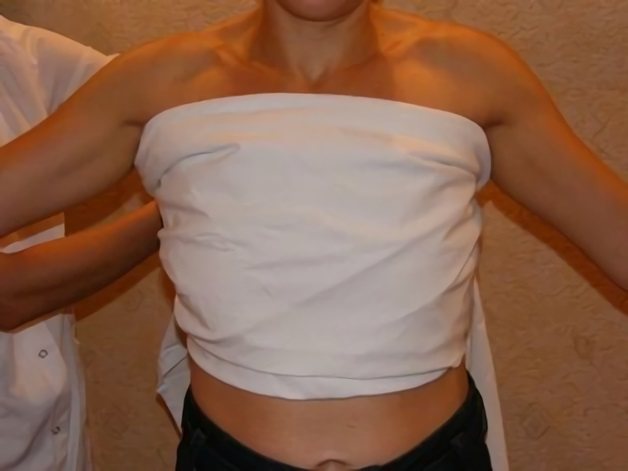
Pediatricians recommend continuing breastfeeding for a long time, the main thing is that the period does not exceed one and a half years. Suppressing lactation and milk production is also a necessary measure. It is needed to stop breastfeeding, and is also often used in cases where breastfeeding can become dangerous to the mother’s health. In this case, experienced specialists recommend correctly stopping the process of breastfeeding the child, doing it gradually.
After some time, the number of feedings per day should be 1 time, and feeding should be done at night or in the evening: the mammary glands naturally slow down and reduce the amount of milk produced. This approach allows the child to get rid of stressful situations due to lack of breasts. They are often associated with a process such as dragging. In addition, a woman planning to ligate the glands is recommended to consume as little liquid as possible and eat garlic, which is the best folk remedy for suppressing lactation.
Weaning a child from the breast, which occurs gradually, is an ideal algorithm, since the process is completely natural and does not cause any harm to either the child or his mother. But in life practice, everything does not always go as right as mothers would like, since the method is not relevant in all cases. And many women have a question about how to do the procedure as competently as possible, so as not to harm their own health.
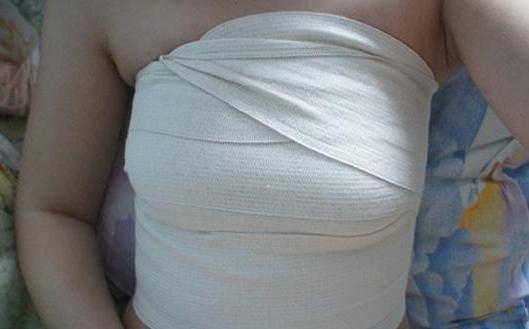
Some doctors note that pulling is not necessary at all, and when a woman decides to stop breastfeeding, the milk will disappear on its own. If milk production continues at this time, the doctor may prescribe hormonal medications.
But when a woman nevertheless decides to bandage her breasts, she must first be emptied. It will be problematic to take a set of measures on her own, so a woman should call her husband for help.
Stages of work:
- First, take a wide towel or sheet.
- You need to use it to wrap yourself around it on all sides and tighten the fabric as tightly as possible.
- It is important that the entire body is tightly cinched.
- After pumping, the bandage is applied again.
The duration of the constriction period cannot exceed 2 or 3 hours a day; sometimes a woman needs 4 days for the volume of breast milk to be sharply reduced, and often lactation can be completely interrupted during this time.
A woman chooses the need for measures, and some new mothers prefer to take medications to stop lactation. Many doctors, including Komarovsky, advocate that women stop this process naturally; many use this risky method, considering it the most effective.
Where does breast milk come from?
After childbirth, milk comes in under the influence of a sharp release of hormones.
Thanks to prolactin, milk is produced in the required volume (more about prolactin during breastfeeding>>>). With the help of oxytocin, it flows from the breast in response to the baby's sucking.
No matter how much you tighten the mammary glands to make milk disappear, it will not go anywhere. Because this is a hormonal process. But you can easily harm yourself.
Important! The whole secret is to reduce the number and intensity of sucking. Then prolactin becomes less and milk volume also decreases.
Oh miracle! You DO NOT need to take dangerous pills to complete lactation, which sometimes lead to irreversible consequences. There is no need to run away from your child for a week and hurt his psyche. There is no need to overtighten or injure your breasts.
How to transfer breast milk?
If you still intend to use the old, proven folk remedy of breast tightening, then you need to figure out how to do it correctly. First, the chest must be completely emptied. Feed your baby or express milk. Secondly, you cannot do without assistants in the process of breast tightening, so ask your husband or mother to pull you well into a wide bath towel or sheet. Make sure that the mammary glands are hidden from the armpits to the lower ribs. If pain occurs in the chest area while wearing a tight bandage, then it is necessary to repeat the procedure of expressing milk. Then put the bandage back on.
How long should you walk with constricted breasts?
Experts recommend starting to “drag out” for several hours a day, since this procedure is quite traumatic for the mammary glands. As soon as you notice that the milk is no longer as intense as before, and the pain in the breast has passed, then you can stop tightening the breast. If the correct technique is followed, the lactation process using this method can be stopped within a week.
What to do then?
Wean your baby smoothly and gently. Show understanding and love.
But! The mother’s attitude is very important here. You must decide for sure that you are ending breastfeeding. This will allow you NOT to feel guilty before your child and confidently refuse to latch on.
Soon the baby will understand that there is no turning back, and will gradually get used to living without mother's milk.
So, a rough weaning plan:
- Start reducing daytime feedings.
They are less important for the baby. If a child asks for tita after waking up or during the day, distract him with a toy or some activity. As a result, 1–3 applications remain.
- Then move on to more difficult ones, and these are naptime and sleep feedings.
It is important here that the child does not associate sucking and falling asleep. Therefore, after applying, for example, give your baby a massage or read. Read an interesting article about rituals before bed>>>
If your baby, out of habit, wants to suck while sleeping, then try stroking it and hugging it gently. The main thing is to be tolerant and consistent.
So, you will help your baby painlessly develop a new habit of waking up and falling asleep without his mother’s breast. We discuss this topic in great detail on the online course How to teach a child to fall asleep and sleep without breastfeeding>>>
Is it possible to do without dragging?
Summarize:
- Tight bandaging does not stop milk production, since it depends entirely on the amount of prolactin and oxytocin in the blood.
- If you tighten your breasts, then the milk that arrives has nowhere to flow out. It accumulates unevenly in the ducts. Seals form. Lactostasis begins: hellish pain in the mammary glands, fever.
- Lactostasis turns into mastitis if it is ignored and tolerated. And this: surgery, antibiotics, scars. And it is unknown whether you will be able to breastfeed in the future.
- Lactation gradually subsides on its own by the age of 3 years.
According to WHO recommendations, breastfeeding is recommended for up to 2 years. And then with the consent of mother and baby. Therefore, you won’t feed forever, that’s for sure. And after 2 years you can safely begin weaning.
- We wean off the breast gently, gradually. And then the process will be painless for both you and the child.
If you want to learn more about stopping breastfeeding without the child’s tears and tantrums, and create your own weaning plan, see the online course Weaning Formula>>>
It turns out that you can wean from the breast and not drag!
Advantages and disadvantages
Ligation of the glands with a wide cloth speeds up the process of completing lactation, and this is the optimal solution for a woman who is forced to urgently go to work or go somewhere alone. Unable to breastfeed, women turn to this procedure.
In their practice, mammologists do not recommend resorting to this method unless absolutely necessary. The bandage can be used only if it is not possible to stop lactation naturally. READ ALSO: how to take Dostinex lactation pills?
There is always a health hazard:
- Damage to soft tissues. A bandage that is too tight can cause chest injury. The presence of pain when tightening is a sign of an excessively tight wrap.
- Mastitis. Tight fixation blocks the milk ducts, and this can lead to lactostasis (more details in the article: symptoms of lactostasis in a nursing mother). Painful lumps are already detected during self-examination. If a “lump” is detected, it must be gently massaged several times a day. If this clot is ignored, infectious mastitis may occur.
- Swelling and pain. Swelling appears in the absence of natural feeding or pumping. Congested breasts cause discomfort and pain. “Stone” breasts can be softened by expressing some of the milk, and pain can be relieved with the help of a painkiller, provided that breastfeeding is completed.
The correct application technique and timely “release” of the engorged glands are absolutely painless. Lactation, therefore, can end in just 1 week (for more details, see the article: What are the foods that reduce lactation?).
Advantages and disadvantages
Like any other method, breast drag has its pros and cons.
Advantages:
- The method is very effective as it blocks the channels through which milk flows.
- The female breast consists of fatty and glandular tissue, which, in turn, is broken into parts. They are the ones who produce milk. Thus, by tightening the breasts, a woman blocks “parts” of the glandular tissue, thereby reducing the volume of breast milk produced.
- Natural interruption of feeding takes a lot of time, since milk is produced in the same quantity as during feeding. Breast tightening allows you to quickly stop lactation.
However, the method entails various kinds of unpleasant consequences. Important note: with a clear understanding of exactly how to tighten the chest, negative effects are minimized.
Flaws:
- The breast, consisting of soft tissue, is easily injured by excessive fixation and tension.
- Stagnant, unexpressed milk can cause the formation of infectious mastitis, which at an early stage has the form of lactostasis. If you find “lumps” in the chest area, you need to break them up manually and knead them throughout the day.
- If there is excessive pressure, pain and discomfort are likely, which is most likely if you refuse to express milk.
Breast ligation as a way to end lactation
Completion of lactation is the same physiological process as breastfeeding. But the body is a complex system in which everything is interconnected. The decrease in milk production occurs gradually, and not at the request of the woman. Experts insist that the best way to stop breastfeeding is to act slowly, giving your organs time to rebuild.
Many women think that during ligation of the mammary glands, milk stops flowing into the ducts and immediately disappears. It's not like that at all. A tight bandage blocks the channels responsible for the flow of nutrient fluid. It is still produced, but the breasts do not fill as quickly, which leads to a decrease in lactation.
Despite the fact that modern medicine denies the effectiveness of breast tightening during the period of cessation of breastfeeding, many young mothers use this particular method and achieve success. They began to use this method a very long time ago, and in the Soviet Union it gained the greatest popularity. Even gynecologists and pediatricians advised applying a tight bandage to the mammary glands to quickly burn out the nutrient fluid.
Women believe that bandaging the breasts is much safer than taking pills, not as troublesome as preparing decoctions and infusions, and faster than gradually reducing the number of feedings and waiting for the milk to go away on its own.
Elastic bandage or diaper: what to choose
For dragging you can use:
- elastic bandage.
It is sold in pharmacies and comes in several types, which differ in width and length. For ease of use, some products have a fastener or Velcro to securely fix the edges after applying the bandage; A woman independently chooses the width of the bandage depending on her breast size. - diaper. Cotton fabric is perfect, preferably without the addition of synthetic threads, plain. The size is also selected individually and depends on the woman’s breast volume.

The elastic bandage can have a fastener, which is very convenient for fixing the bandage.
Some young mothers prefer to use a regular medical bandage, but due to the characteristics of the material and the loose weaving of the threads, it will not be possible to tighten the breasts well with its help.
When choosing an elastic bandage or diaper, it is necessary to take into account that the bandage should cover not only the entire surface of the chest, but also the ribs and collarbones.
Technique of pulling the mammary glands
Experts recommend starting to reduce feedings approximately seven to ten days before tugging, leaving one feeding at night or during the day. The less milk is produced in the mammary glands, the less likely it is that fluid stagnation will occur.
A gradual reduction in the number of feedings will lead to a natural decrease in the formation of nutrient fluid. A tight bandage will help reduce the flow of milk into the ducts.
Before you start dressing, you need to express completely. This can be done with your hands or using a breast pump. Then the entire surface of the mammary glands is palpated to make sure there are no lumps or fluid stagnation in the breast. A woman should know: if she begins to experience lactostasis, it is strictly forbidden to overtighten. This can lead to complications such as mastitis.
- Take an elastic bandage or a thick diaper.
- Apply the fabric to the mammary glands, taking into account that the bandage starts from the armpits and ends in the area of the lower ribs.
- Pull the fabric tightly and, if necessary, wrap it several times around the body.
- Tie the edges of the bandage at the back. If you are using a bandage with a clasp, secure it in any place convenient for you.
In most cases, you won’t be able to apply the bandage yourself, so it’s better to ask your husband or other relatives for help.
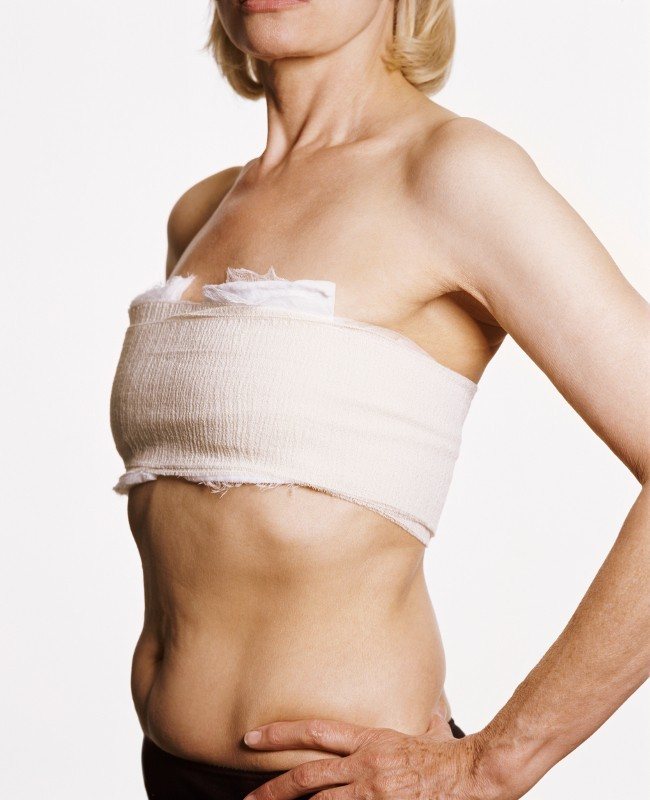
It is best to tighten your breasts with an elastic bandage
It is worth noting that the bandage should not cause discomfort to the woman. Many mothers, trying to stop milk production as quickly as possible, tighten the fabric very tightly. This is the wrong approach. When the breast tightening technique is performed correctly, there is no pain in the mammary glands or nipple area.

The bandage on the chest should be tight, but not painful
How long should breasts be constricted?
Many women are sure that they need to wear the bandage constantly for several days. This is the main misconception. Before you decide to use a dressing to complete lactation, be sure to remember the simple rules:
- the breasts can be kept constricted for no longer than two to three hours a day;
- the maximum time for using the method is two to four weeks, depending on the individual characteristics of the woman;
Most young mothers note that after a week the milk practically does not come. - if while wearing a bandage a woman feels a strong influx of fluid, her breasts begin to hurt, she urgently needs to release the mammary glands and express them until relief;
- simultaneously with dressing, it is recommended to use other folk methods, for example, drinking a decoction of sage, mint or infusions of herbs that have a diuretic effect.
How should the dressing be done?
The lactation process is stimulated by feeding and pumping. Before ligating the mammary glands, they should be completely free of milk. You can put the baby to the breast or just pump well. Afterwards you can begin the process of dragging. Can't do it without helpers. Using a wide bath towel or sheet from the armpits to the line of the lower ribs, the entire chest area is pulled quite tightly. A medical elastic bandage that is used to support varicose veins is good for this purpose. It contains enough cotton and elastic fibers. It will be more pleasant, will do its job well and at the same time will allow the woman to breathe normally.
The bandage should lie evenly, cover the mammary glands without gaps and overlaps with layers of bandage tapes.
If a woman is faced with such a procedure for the first time, it is advisable that a person with experience first apply a bandage and show how it is done correctly. You can ask an experienced midwife for help.
If unpleasant pain appears in the mammary glands and milk comes in, you should unbandage the bandage, express until the last drop and then bandage it again. You can only walk in a sling for a few hours a day. Tugging is a procedure that can not only injure the mammary glands, but also disrupt blood circulation and lymph flow. It is better to discuss this issue with a specialist in advance to avoid unpleasant consequences.
It should be remembered that the mammary gland is one of the most vulnerable organs in the female body. Especially during periods of hormonal storms: pregnancy, postpartum period, lactation. Lactostasis, mastitis and mastopathy in the future are an incomplete list of diseases that can be caused by improper breast tightening technique.
Folk remedies to reduce lactation
Folk remedies will help relieve swelling and pain in the first days of the “constriction”, but it is recommended to use them from the very first day of the procedure:
- Decoctions of sage and mint. These types of herbs are considered excellent sedatives and at the same time they reduce milk production. You should drink about 0.5 liters of this infusion per day.
- Reducing fluid intake. This restriction is temporary, but soups, teas and juices should be excluded from the diet. Drink herbal infusions in small sips throughout the day. A large amount of liquid provokes active milk flow. Dr. Komarovsky also mentions this rule, pointing out that it is no longer worth forcing yourself to drink liquid, as is necessary to increase lactation.
- Cabbage leaves. They can relieve pain and create a cooling effect. Whey applied to cheesecloth can be an alternative to cabbage.
A woman will be able to do without hormonal medications if she helps herself with the above-mentioned folk remedies. It is strongly recommended that every nursing mother has an understanding of the correct procedure for carrying out the tugging procedure. Knowing these rules, she will protect her health and be able to complete lactation, if necessary, quickly and safely.
What is the meaning of the procedure
There is an opinion that ligation of the mammary glands is an exclusively folk remedy that allows you to stop lactation. However, this idea is incorrect, because, according to mammologists, modern medicine refers to it quite often. So, ligation of the glands may be necessary in the following situations:
- cessation of breastfeeding in accordance with medical indicators - in the presented situation, continued lactation will be extremely dangerous for the child. Such risks arise in specific situations, for example, when the mother develops infectious pathological conditions, which the child can become infected with in the process of drinking milk,
- cessation of lactation in accordance with the wishes of the mother.
Mammologists draw attention to the fact that a baby should not be weaned from lactation before the age of one year. Until this age, the lactation period must be perceived as the key to the formation of an optimal immune system, the ideal physical and mental development of a small person. After the child reaches the age of 12 months, weaning will not have such a negative impact on the child, but only in a situation where complementary feeding was introduced within the time frame recommended by experts.
Folk remedies to reduce lactation
You can stop lactation with the help of various herbal teas and infusions. Suitable:
- Jasmine.
- Bearberry.
- Lingonberry decoction.
- Horsetail.
- Elecampane.
- Parsley.
Thanks to these remedies, you can rid a woman’s body of unnecessary fluid. The infusions should be taken for no more than ten days.
In order to stop lactation, you can also use the following:
- Belladonna.
- Sage.
- Camphor compress.
- Peppermint.
- Ice compress.
- Cabbage leaves are a compress.
It should be remembered that it is dangerous to use all these remedies without a doctor’s recommendation!
Medications
Currently, scientists have developed many different medications that can stop lactation.
Medicines, of course, cause harm to women’s bodies, but not much. These drugs do not have a very good effect on the brain and the thyroid gland. Before using medications, it is better to consult a pediatrician.
Medicines against lactation:
- "Dostinex" - this drug affects the production of prolactin. This drug is taken when milk urgently needs to be stopped, but there is no time for this. The effect of Dostinex can be observed two days after taking it.
- Bromcamphor is a non-hormonal medicine that has a sedative effect. If you have a diseased liver or kidneys, this drug is contraindicated for you. This drug is prescribed in cases where cessation of lactation is not urgently required.
- "Bromocriptine" - this remedy is used to adjust your menstrual cycle and get rid of lactation. The medicine may increase your blood pressure. It can cause an effect only when taken for at least four days.
While you are taking the pill, you may need to express breast milk occasionally. At this time, you should prepare a thick, wire-free bra. While taking medications, do not tighten the chest with a bandage.
